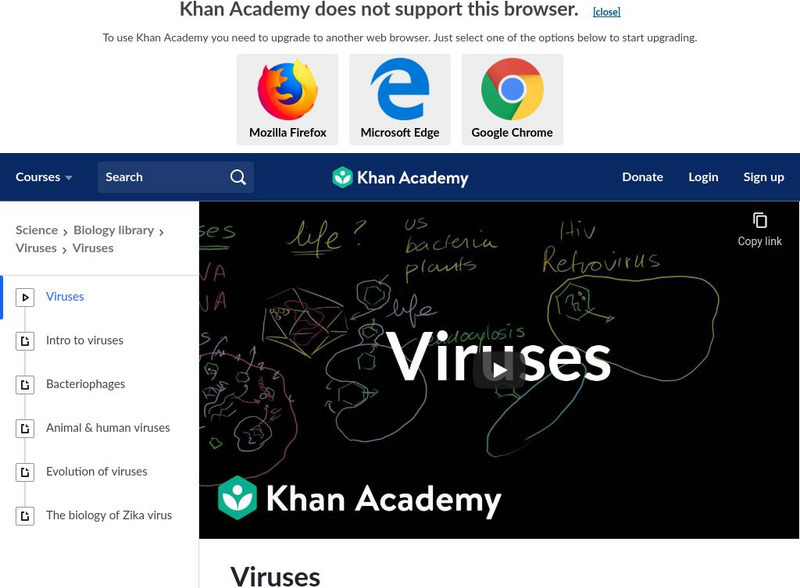SciShow
The Virtually-Unkillable Virus That Makes Itself a Nucleus
In 2017, scientists discovered what appeared to be an unkillable virus that does something very un-virus-like... it builds its own nucleus inside its host's cells!
Crash Course
The Digestive System: CrashCourse Biology
Hank takes us through the bowels of the human digestive system and explains why it's all about surface area.
SciShow
Flowers, Bees, and... Yeast? It's a Pollination Love Triangle!
Bees and flowers are as classic a pair as peanut butter and jelly. But recent research suggests there's a third, much tinier partner in this relationship!
SciShow
Biofilm: A New (Gross) Thing to Worry About
Slime can be great, but when it's the wrong kind of slime (you know, the kind that can kill you?), it gets added to the list of things Hank wishes he didn't have to worry about. Scientists call it biofilm, and it's a type of bacterial...
SciShow
Dangerous Soaps: How Animals Use Surfactants
When you think of surfactants, you might think of soaps, detergents and other man-made chemicals. But it turns out that some other animals utilize their own versions of these sudsy molecules.
Curated Video
Microorganism
Or microbe, is an organism too small to be seen by the human eye. A Twig Science Glossary Film. Key scientific terms defined in just 60 seconds using stunning images and concise textual definitions. Twig Science Glossary Films reinforce...
Curated Video
Bacteria
Single-celled microorganisms, which do not have a nucleus, and reproduce by simple cell division. A Twig Science Glossary Film. Key scientific terms defined in just 60 seconds using stunning images and concise textual definitions. Twig...
Curated Video
Vaccine
A preparation that can protect against a specific disease. A Twig Science Glossary Film. Key scientific terms defined in just 60 seconds using stunning images and concise textual definitions. Twig Science Glossary Films reinforce...
Curated Video
Oceans: The Intertidal Zone
Discover how ever-changing tidal ecosystems create opportunities for both predators and prey. Biology - Ecosystems - Learning Points. Tides are a powerful force of nature, created by the Moon's gravitational pull. Tides affect marine...
Curated Video
Fermentation: The Chemical Process Behind Everyday Foods
Discover the chemical process which produces some of our most common foodstuffs, from bread to yoghurt, to wine and vinegar. Chemistry - Chemical Industries - Learning Points. Fermentation is the process of converting sugar and other...
Curated Video
What is a microorganism?
Microorganisms live everywhere on Earth, but what are they and how do they affect humans? Life processes - Humans and other animals - Microorganisms Learning Points Microorganisms are so small they can only be seen with a microscope....
Curated Video
GCSE Biology - What Is Blood Made of? / What Does Blood Do? #25
Ever wondered what your blood is made of? Red blood cells, white blood, platelets and plasma! Learn what each of these components does and how we can replace it with artificial blood.
Professor Dave Explains
Synthetic Biology and Materials Science Part 2: Nature-Made Plastics
In the previous tutorial we outlined the basics regarding synthetic biology as applied to materials science. We can engineer microorganisms that will produce virtually any compound we want, via a series of reactions that are catalyzed by...
Visual Learning Systems
Introduction to Classifying Life
This video introduces the Classifying Life series. This program explores the fascinating process of taxonomy, explaining why the process of classification is so important. Some of the criteria taxonomists use in classifying living things...
Next Animation Studio
Scientists discover fish parasites that do not breathe: study
The Henneguya salminicola is the first multicellular animal discovered that does not breathe.
Curated Video
Physical Defenses Against Pathogens
This video is a lecture presentation on physical defenses against pathogens. The presenter discusses the ways in which pathogens can be transmitted from one host to another and how we can limit their spread through measures such as good...
Professor Dave Explains
Microorganisms and Humans Commensal and Pathogenic Flora
Did you know that there are more microbes inside of you than there are cells that belong to your own body? There are tons of those critters all over the place! But don't freak out, most of them are actually helping you. They protect you...
Professor Dave Explains
The Birth of Microbiology
As we have come to understand in this series, the most devastating diseases to ever plague mankind have been the cause of pathogenic organisms. Although strategies had been developed to combat some of these diseases, it was not until the...
FuseSchool
Human Defence Systems Against Pathogens
Human Defence Systems Against Pathogens | Health | Biology | FuseSchool Pathogens are disease causing microorganisms, that our body has many defence mechanisms against. The skin is the first physical barrier, providing a protective layer...
Journey to the Microcosmos
How Microscopic Hunters Get Their Lunch
On this week's journey, we explore the ways things eat in the microcosmos, from Stentors filter feeding to Dileptus hunting down and absorbing its prey.
Mazz Media
Biological Vectors and Infectious Diseases
REAL WORLD SCIENCE: Biological Vectors and Infectious Diseases
Using incredible videography, photos, animation and graphics, this information-packed video introduces students to biological vectors. Viewers will learn that biological...
FuseSchool
What Are Pathogens?
A pathogen is a microorganism that can cause disease. Pathogens may be viruses, bacteria, protists or fungi. Examples of bacteria infections are cholera, typhoid, food poisoning and gonorrhoea. Examples of viral infections are the flu...
Science for Kids
Science Kids: Scientist Videos: Louis Pasteur Biography
Find out about Louis Pasteur, an influential chemist and microbiologist who made important discoveries related to the immune system, microorganisms and disease. [1:35]


